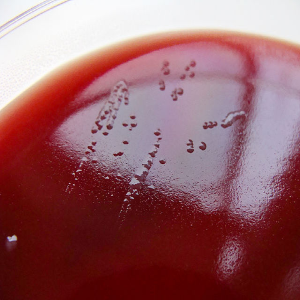Comparison of the Etest and Sensititre methods for anaerobe susceptibility testing

Accepted: 17 February 2023
HTML: 21
All claims expressed in this article are solely those of the authors and do not necessarily represent those of their affiliated organizations, or those of the publisher, the editors and the reviewers. Any product that may be evaluated in this article or claim that may be made by its manufacturer is not guaranteed or endorsed by the publisher.
Background and Aims: Antimicrobial susceptibility testing of anaerobic clinical isolates is of paramount importance for patient therapy and resistance monitoring. In our laboratory the MIC gradient Etest method and broth microdilution with Sensititre trays are used for susceptibility testing of anaerobes and the aim of this study was to compare the two methods on a panel of anaerobes routinely isolated from patients in the province of Bolzano, Italy. Materials and Methods: Totally, 74 non-repetitive Gram-positive and Gram-negative patient isolates were tested with Etest strips on Fastidious Anaerobe Agar (F.A.A.) and with Sensititre trays, according to manufacturer’s instructions. Interpretation of MICs was by EUCAST or CLSI criteria, resistance percentages were calculated and Categorical Agreement (CA) and Essential Agreement (EA) between the two methods were determined. Results: Of the 74 isolates, 68 (91.9%) grew on both systems and agreement for these was compared in the study. CA for all isolates was ≥90% for all tested antibiotics except moxifloxacin, whereas EA was generally lower. Resistance was generally low, except for clindamycin in all isolates and tigecycline in Gram-negatives. In our study Etest was a superior and more handy method. Conclusions: To conclude, we believe the Etest method is more suitable for routine diagnostic laboratory usage. Nevertheless, multicenter studies are required to evaluate the two methods for anaerobic susceptibility testing.
Baquer F, Sawan AA, Auzou M, et al. Broth microdilution and gradient diffusion strips vs. reference agar dilution method: first evaluation for Clostridiales species antimicrobial susceptibility testing. Antibiotics 2021;10:975. DOI: https://doi.org/10.3390/antibiotics10080975
Brook I, Wexler HM, Goldstein EJ. Antianaerobic antimicrobials: spectrum and susceptibility testing. Clin Microbiol Rev 2013;26:526-46. DOI: https://doi.org/10.1128/CMR.00086-12
Cherkaoui A, Fischer A, Azam N, et al. A comparison of SentititreTM Anaerobe MIC plate with ATB ANA® test for the routine susceptibility testing of common anaerobe pathogens. European Journal of Clin Microbiol & Infect Dis 2018;37:2279-84. DOI: https://doi.org/10.1007/s10096-018-3369-5
Clinical and Laboratory Standards Institute (CLSI). Methods for antimicrobial susceptibility testing of anaerobic bacteria: approved standard – eighth edition. M11-A8, Vol. 32 No. 5. Wayne, PA, USA: Clinical and Laboratory Standards Institute. 2012. Available from: https://clsi.org/media/1468/m11a8_sample.pdf
Clinical and Laboratory Standards Institute (CLSI). Performance Standards for Antimicrobial Susceptibility Testing, M100-Ed. 32, 2022. Wayne, PA, USA. Available from: https://clsi.org/standards/products/microbiology/documents/m100/
Di Bella S, Antonello RM, Sanson G, et al. Anaerobic bloodstream infections in Italy (ITANAEROBY): a 5-year retrospective nationwide survey. Anaerobe 2022;75:102583. DOI: https://doi.org/10.1016/j.anaerobe.2022.102583
European Committee on Antimicrobial Susceptibility Testing (EUCAST, https://www.eucast.org). Antimicrobial susceptibility tests on groups of organisms or agents for which there are no EUCAST breakpoints
European Committee on Antimicrobial Susceptibility Testing (EUCAST, https://www.eucast.org). Breakpoint tables for interpretation of MICs and zone diameters. Version 12.0.
Hughes C, Ashhurst-Smith C, Ferguson JK. Gram negative anaerobe susceptibility testing in clinical isolates using Sensititre and Etest methods. Pathology 2018;50:437-41. DOI: https://doi.org/10.1016/j.pathol.2017.10.020
ISO 20776-2. Clinical laboratory testing and in vitro diagnostic test systems – susceptibility testing of infectious agents and evaluation of performance of antimicrobial susceptibility test devices – Part 2: evaluation of performance of antimicrobial susceptibility test devices. 2007. Available from: http://www.iso.og/standard/41631-html.
Nagy E, Boyanova L, Justesen US, on behalf of ESCMID Study group of anaerobic infections. Clin Microbiol Infect 2018;24:1139-48. DOI: https://doi.org/10.1016/j.cmi.2018.02.008
Schuetz AN. Antimicrobial resistance and susceptibility testing of anaerobic bacteria. Clin Infect Dis 2014;59:698-705. DOI: https://doi.org/10.1093/cid/ciu395
Van der Zwaluw K, de Haan A, Pluister GN, et al. The carbapenem inactivation method (CIM), a simple and low cost alternative for the carba NP test to assess phenotypic carbapenemase activity in Gram-negative rods. PLOSone 2015;10:e0123690. DOI: https://doi.org/10.1371/journal.pone.0123690
Wolff A, Rodloff AC, Vielkind P, et al. Antimicrobial Susceptibility of Clinical Oral Isolates of Actinomyces spp. Microorganisms 2022;10:125. DOI: https://doi.org/10.3390/microorganisms10010125
Copyright (c) 2023 the Author(s)

This work is licensed under a Creative Commons Attribution-NonCommercial 4.0 International License.
PAGEPress has chosen to apply the Creative Commons Attribution NonCommercial 4.0 International License (CC BY-NC 4.0) to all manuscripts to be published.


 https://doi.org/10.4081/mm.2023.11056
https://doi.org/10.4081/mm.2023.11056



